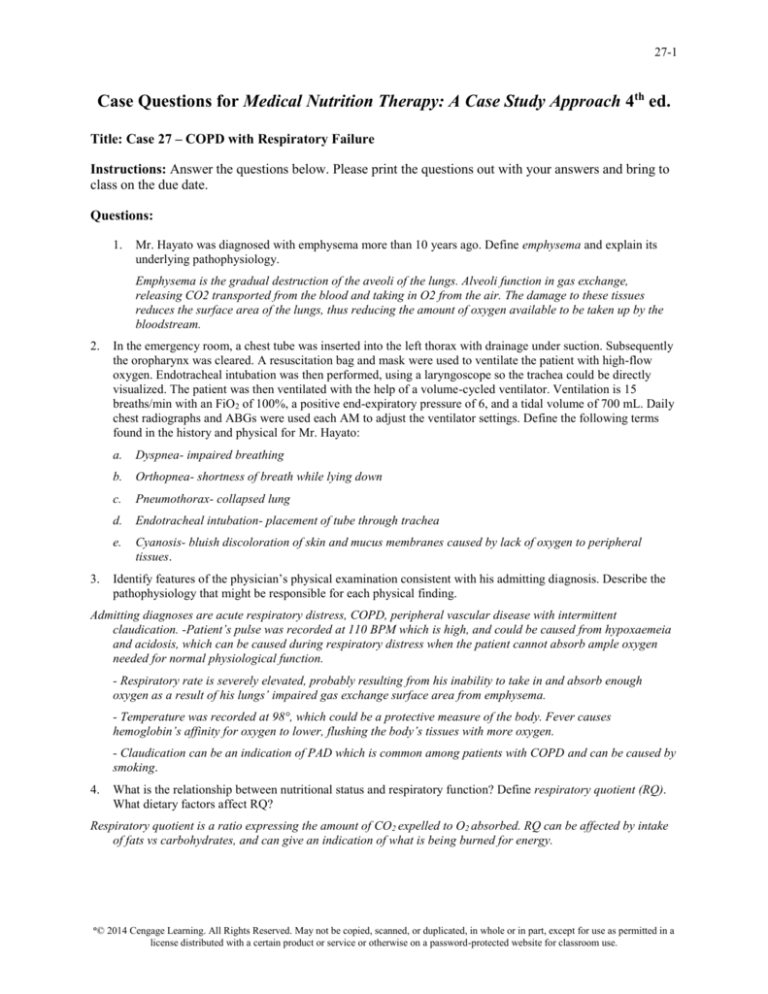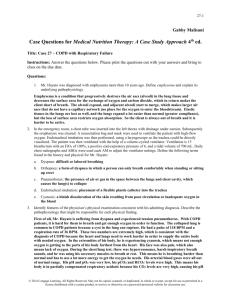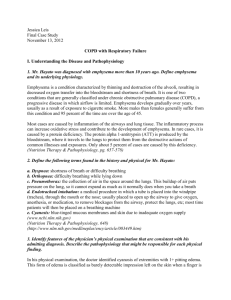
27-1
Case Questions for Medical Nutrition Therapy: A Case Study Approach 4th ed.
Title: Case 27 – COPD with Respiratory Failure
Instructions: Answer the questions below. Please print the questions out with your answers and bring to
class on the due date.
Questions:
1.
Mr. Hayato was diagnosed with emphysema more than 10 years ago. Define emphysema and explain its
underlying pathophysiology.
Emphysema is the gradual destruction of the aveoli of the lungs. Alveoli function in gas exchange,
releasing CO2 transported from the blood and taking in O2 from the air. The damage to these tissues
reduces the surface area of the lungs, thus reducing the amount of oxygen available to be taken up by the
bloodstream.
2.
3.
In the emergency room, a chest tube was inserted into the left thorax with drainage under suction. Subsequently
the oropharynx was cleared. A resuscitation bag and mask were used to ventilate the patient with high-flow
oxygen. Endotracheal intubation was then performed, using a laryngoscope so the trachea could be directly
visualized. The patient was then ventilated with the help of a volume-cycled ventilator. Ventilation is 15
breaths/min with an FiO2 of 100%, a positive end-expiratory pressure of 6, and a tidal volume of 700 mL. Daily
chest radiographs and ABGs were used each AM to adjust the ventilator settings. Define the following terms
found in the history and physical for Mr. Hayato:
a.
Dyspnea- impaired breathing
b.
Orthopnea- shortness of breath while lying down
c.
Pneumothorax- collapsed lung
d.
Endotracheal intubation- placement of tube through trachea
e.
Cyanosis- bluish discoloration of skin and mucus membranes caused by lack of oxygen to peripheral
tissues.
Identify features of the physician’s physical examination consistent with his admitting diagnosis. Describe the
pathophysiology that might be responsible for each physical finding.
Admitting diagnoses are acute respiratory distress, COPD, peripheral vascular disease with intermittent
claudication. -Patient’s pulse was recorded at 110 BPM which is high, and could be caused from hypoxaemeia
and acidosis, which can be caused during respiratory distress when the patient cannot absorb ample oxygen
needed for normal physiological function.
- Respiratory rate is severely elevated, probably resulting from his inability to take in and absorb enough
oxygen as a result of his lungs’ impaired gas exchange surface area from emphysema.
- Temperature was recorded at 98°, which could be a protective measure of the body. Fever causes
hemoglobin’s affinity for oxygen to lower, flushing the body’s tissues with more oxygen.
- Claudication can be an indication of PAD which is common among patients with COPD and can be caused by
smoking.
4.
What is the relationship between nutritional status and respiratory function? Define respiratory quotient (RQ).
What dietary factors affect RQ?
Respiratory quotient is a ratio expressing the amount of CO2 expelled to O2 absorbed. RQ can be affected by intake
of fats vs carbohydrates, and can give an indication of what is being burned for energy.
ᵒ© 2014 Cengage Learning. All Rights Reserved. May not be copied, scanned, or duplicated, in whole or in part, except for use as permitted in a
license distributed with a certain product or service or otherwise on a password-protected website for classroom use.
27-2
Respiratory function is absolutely necessary for the function of all other systems, so naturally, poor respiratory
function can result in poor nutritional status. Many patients with inhibited respiratory function have difficulty
eating, or eating enough. Because COPD patients have increased energy and protein needs, failure to fulfill
these needs can result in muscle and tissue wasting. Wasting in areas of the respiratory system such as the
diaphragm can encourage a sort of positive feedback loop of progressive degeneration and worsening function.
Depletion of minerals and electrolytes can contribute to acid/base imbalances, muscle wasting and
dehydration.
5.
Do nutrition support and nutritional status play a role in enabling a patient to be weaned from a respiratory
ventilator? Explain.
Probably. It seems that early administration of protein and energy support can address the potential loss of muscle
in ventilated patients, including the diaphragm muscle, which as previously mentioned, is at risk of loss of mass
from malnutrition and will result in reduced pulmonary function if compromised.
6.
Evaluate Mr. Hayato’s admitting anthropometric data.
BMI- 20.9
IBW- 130
CBW- 122
% IBW- 94%
UBW-135
%UBW-90%
Mr. Hayato’s BMI may be normal, but his weight loss of 13 pounds in a matter of weeks is cause for alarm.
7.
Determine Mr. Hayato’s energy and protein requirements using the Mifflin-St. Jeor, Ireton-Jones, and COPD
predictive equations. Compare them. As Mr. Hayato’s clinician, which would you set as your goal for meeting
his energy needs?
MSJ-(10*55.5)+(6.25*162.56)-(5*65)+5)1.75 =
550+1016-325+5=1246*1.75= 2180.5 kcal/day
IJ- 629 - 11 (65) + 25 (55.5) =
629-715+1387.5=1301.5 kcal/day
COPD predictive equation:
125-156% above BMR 25-30 * 55.5 = 1387.5-1665= average of 1526*1.25-1.56 = 1907.5-2380.56 kcal
Protein: 1.2-1.7 g/kg = 66.6-94.3 g/PRO/day
In the case of Mr. Hayato, I would choose the Mifflin-St.Jeor Equation, as it is much higher than the Ireton-Jones
and about in the middle of the COPD predictive equation and would be providing him with the necessary energy to
maintain his current lean body mass during recovery.
8.
Determine Mr. Hayato’s fluid requirements.
35*55.5=1942.5 mL/day
9.
Evaluate Mr. Hayato’s biochemical indices relevant to nutritional status on 3/26.
Mr. Hayato’s hemoglobin and hematocrit are low due to decreased oxygen availability. His pH and pO 2 are also
low, while his pCO2 , CO2, and HCO3- are high, indicating respiratory acidosis as a result of impaired
respiratory function. His lymphocytes are low, suggesting poor nutritional maintenance. His LDL/HDL ratio is
high indicative of PVD, which, along with CVD, can be cited in complications with many fatal cases of
pulmonary disease.
10. Select two high-priority nutrition problems and complete the PES statement for each.
Unintended weight loss RT inadequate oral intake, poor appetite AEB 10% body weight loss in <6 months.
© 2014 Cengage Learning. All Rights Reserved. May not be copied, scanned, or duplicated, in whole or in part, except for use as permitted in a
license distributed with a certain product or service or otherwise on a password-protected website for classroom use.
27-3
Inadequate oral intake RT food- and nutrition-related knowledge deficit of COPD management AEB unintended
weight loss of 13 lbs.
11. A nutrition consult was completed on 3/27, and enteral feedings were initiated. Mr. Hayato was started on
Isosource HN @ 25 cc/hr continuously over 24 hours.
a.
At this rate, how many kcal and grams of protein should he receive per day?
25cc*24=600cc/day*1.2=720 kcal/day
PRO=129.6/4=32.4 g/day
b.
Calculate his nutrition prescription utilizing this enteral formula. Include the goal rate, free water
requirements, and the appropriate progression of the rate.
GOAL RATE- 2180/1.2=1817/24=75.7= 76cc/hr @ 24 hr/day
H2O @ 82% = 1490 mL/free water in formula
Flush with 115 mL/H2O every 5 hours = 1950 mL total water
12. What type of formula is Isosource HN? What are the percentages of kilocalories from carbohydrate, protein,
and lipid? What is the rationale for formulas that have additional nutrients added to assist with pulmonary
function? List these nutrients and the proposed rationale.
Isosource HI is a high-nitrogen standard formula
kcal/mL: 1.2
Protein: 18% Carbohydrate: 53% Fat: 29%
Formulas for patients with pulmonary disease have higher ratios of lipids to carbohydrates, because it can help
increase the amount of oxygen consumption to carbon dioxide expulsion. This formula his high amounts of
antioxidants, calcium, and electrolytes to decrease tissue loss, maintain lean body mass and ensure hydration
status and with cellular function. Patients with pulmonary disease often experience deficiencies with these
nutrients and can frequently become malnourished, with high nutritional risk.
13. Examine the intake/output record. How much enteral feeding (kcal, protein) did the patient receive?
400 mL*1.2 kcal/mL=480 kcal
PRO-480 kcal *.18 = 86.4/4 = 21.6 g
14. You read in the physician’s orders that the patient experienced high gastric residual volume (GRV) and the
enteral feeding was discontinued. Define high GRV. What is the probable cause for this patient?
Gastric residual volume is the amount of food (formula) still in the stomach after a certain check point, usually 4-8
hours. This was probably caused in this patient by hyperglycemia resulting from refeeding syndrome.
15. Were any additional signs of EN intolerance documented? Do you agree with the decision to discontinue the
feeding? Why or why not?
I did not see any further signs of intolerance documented, though we do not have any documentation of physical
examination, bowel movements, etc. from 3/27.
I disagree with the total discontinuation of enteral feeling. This patient is at high nutritional risk, and as previously
discussed, pulmonary disease can be greatly exacerbated by poor nutritional status.
16. What options are available to improve tolerance of the tube feeding?
The patient can be started on a slower dose, monitored closely and supplemented with extra electrolytes.
17. On 3/29, the enteral feeding was restarted at 25 mL/hr and then increased to 50 mL/hr after 12 hours. What
were Mr. Hayato’s energy and protein intakes for 3/29?
25*12*1.2= 360 kcal + (50*12*1.2= 720) = 1080 kcal
PRO = 360(.18)+ 720(.18)= 64.8+129.6=194/4= 48.6 g
18. Examine the values documented for arterial blood gases (ABGs).
ᵒ© 2014 Cengage Learning. All Rights Reserved. May not be copied, scanned, or duplicated, in whole or in part, except for use as permitted in a
license distributed with a certain product or service or otherwise on a password-protected website for classroom use.
27-4
a.
On the day Mr. Hayato was intubated, his ABGs were as follows: pH 7.2, pCO 2 65, CO2 35, pO2 56, HCO338. What can you determine from each of these values?
pH 7.2 – low, indicative of acidosis, large amounts of carbonic acid in blood
pCO2 65 – high, respiratory acidosis, failure to adequately expel CO2 or absorb enough O2, impaired
ventilation
CO2 35 –CO2content in blood is high, indicating impaired breathing, and/or impaired gas exchange
function;CO2 is not being expelled efficiently
pO2 56 – low partial pressure of O2 indicating impaired breathing, and/or impaired gas exchange function, O2
is not being absorbed efficiently.
HCO3- 38- amount of bicarbonate in bloodstream is high, which should normally help to balance the amount of
acid in the bloodstream, but in this case is a compensatory response to respiratory acidosis.
b.
On 3/28, while Mr. Hayato was on the ventilator, his ABGs were as follows: pH 7.36, pCO2 50, CO2 29,
pO2 60, HCO3- 32. What can you determine from each of these values?
pH 7.36- the patient is back to normal pH
pCO2 50- Still a bit high, but much closer to normal range
CO2 29- Arterial CO2 content is within normal range
pO2 60- Still a bit low, but getting closer normal range.
HCO3- 32- Still a little high, but getting closer to normal range.
c.
On 3/30, after the enteral feeding was resumed, his ABGs were as follows: pH 7.22, pCO2 66, pO2 57, CO2
36, HCO3- 37. In addition, indirect calorimetry indicated an RQ of 0.95 and his measured energy intake was
1350 kcal. How does the patient’s measured energy intake compare to your previous calculations? What
does the RQ indicate?
Mr. Hayoto’s energy intake is still much lower than I’d like to see it, but is an improvement from where he was
upon admittance.
His respiratory quotient indicates he is burning carbohydrates as his primary energy source and producing
more CO2.
19. The patient was weaned from the ventilator on 4/2 and discharged to home on 4/5. As Mr. Hayato is prepared
for discharge, what nutritional goals might you set with him and his wife to improve his overall nutritional
status?
-Maintain lean body mass
-Prevent further weight loss
-Goal intake of 2180 kcal/day
-Goal protein of at least 66 g/day
-Manage drug/nutrient interactions
-Maintain electrolyte/fluid balance
-Take daily multivitamin
-Return client to IBW of 130 within 6 months
© 2014 Cengage Learning. All Rights Reserved. May not be copied, scanned, or duplicated, in whole or in part, except for use as permitted in a
license distributed with a certain product or service or otherwise on a password-protected website for classroom use.









